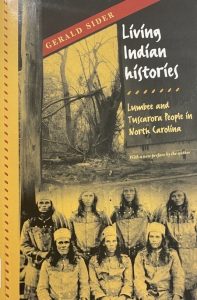NOTE: THIS WEBSITE IS A WORK IN PROGRESS. RESOURCES AND DATA ARE ADDED DAILY.
IMPORTANT: We are in urgent need of funding to keep this project alive and ensure its future. If you’re enjoying the site and see our vision for the project, please consider joining as a paid member or contributing to our crowdfunding campaign today. It is only with your help that we can continue this work.
Thanks so much for your support! – Jes
![]()
0
Living Indian Histories: Lumbee and Tuscarora People in North Carolina
Resource ID: 7317
Type: non-fiction, book
share:
Some buttons on this page link to external websites. If you visit one of our affiliate sites and make a purchase, I may receive a small commission at no extra cost to you. More info
- UPDATED: 10.12.2025
- status: to be worked, high-priority
- Peoples, Indigenous History, History
author:
Gerald Sider
editor:
n/a
publisher:
date:
11.24.2003
ISBN:
9780807855065
pages:
392
notes:
. . .
contents:
description:
With more than 40,000 registered members, the Lumbee Indians are the ninth largest tribe in the country and the largest east of the Mississippi River. Despite the tribe's size, the Lumbee lack full federal recognition and their history has been marked by a struggle to articulate an Indian identity against the imposition of non-native definitions of Indianness. Gerald Sider explores the complexities of Lumbee tribal identity, focusing on the tribe's socioeconomic and political history from the 1960s through the 1980s and working back to the colonial roots of present issues and questions, including the relationship between the Lumbee and Tuscarora people of Robeson County, North Carolina.
In an extensive preface to this new edition, Sider carries the story forward from the 1980s to the present. Today, both the Lumbee and the reinvigorated Tuscarora are witnessing a major cultural resurgence. At the same time, they are becoming much more dependent upon government programs for their well-being, and socioeconomic inequality among native people is deepening. This new edition explores changing patterns of daily life for native people, their changing relations to social and governmental institutions, and the new tribal institutions that are taking shape in the face of current challenges.
An earlier edition of this book was published in 1993 with the title Lumbee Indian Histories: Race, Ethnicity, and Indian Identity in the Southern United States.
In an extensive preface to this new edition, Sider carries the story forward from the 1980s to the present. Today, both the Lumbee and the reinvigorated Tuscarora are witnessing a major cultural resurgence. At the same time, they are becoming much more dependent upon government programs for their well-being, and socioeconomic inequality among native people is deepening. This new edition explores changing patterns of daily life for native people, their changing relations to social and governmental institutions, and the new tribal institutions that are taking shape in the face of current challenges.
An earlier edition of this book was published in 1993 with the title Lumbee Indian Histories: Race, Ethnicity, and Indian Identity in the Southern United States.
places:
CMOS:
author-date:

